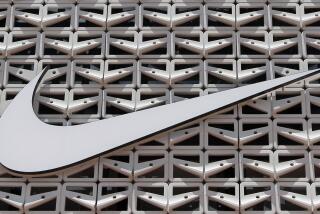Pacific Sunwear Stock Dips on Weak Sales
- Share via
Shares of Pacific Sunwear of California Inc. fell 23% after the retailer of clothing for teenagers warned that its quarterly profit may miss forecasts because of lower-than-expected sales.
Amid a weakening in retail sales and the clothing sector, the Anaheim company’s stock fell $3.63 Thursday to close at $12.44 a share--the biggest drop among apparel companies and eighth-steepest fall overall on Wall Street.
Sales at Pacific Sunwear and at competitors like Ross Stores Inc., Abercrombie & Fitch Co. and American Eagle Outfitters were hurt by unseasonably cool weather, cutting demand for summer clothes such as shorts.
Sales for teen-fashion companies also were hurt by a lack of a trend driving young men’s fashion.
“Was it a demand issue or a weather issue or a fashion issue? It’s a little bit of each one,” said Banc of America Securities analyst Thomas Tashjian.
Steven Richter, an analyst at Tucker Anthony Cleary Gull, said that while it has been a “tough spring from the weather point of view,” clothing retailers are facing other problems.
“There’s not one inspirational look for [Pacific Sunwear] and for many retailers,” he said, as there was for them with the cargo pants or wide-legged jeans that drove young men’s fashion in the past few years.
In addition, shoppers paying higher interest on their credit cards and higher gas prices are slowing spending from the red-hot pace seen last year and earlier this year, analysts said, even though U.S. consumer confidence hit a four-month high in May.
“The continuing series of interest rate increases is beginning to take a bit of a bite,” said Kurt Barnard, president of Barnard’s retail trend report. “We are beginning to see what I call a slowing of growth in the retail sector.”
The drop in the value of Pacific Sunwear stock follows last Friday’s 27% drop amid concerns about anticipated May sales. Through Thursday’s trading, the stock has fallen 50% this year.
Pac Sun said Thursday that sales at stores open at least a year rose just 0.5% last month. The company said that if same-store sales in June and July rise less than 6%, its fiscal second-quarter profit may fall below the average estimate of 29 cents a share forecast by analysts polled by First Call/Thomson Financial.
The company’s same-store sales were at their lowest point in May since November 1998, when sales declined 1.6%.
Same-store sales are a key measure of a retailer’s business because they exclude new and closed stores. Pacific Sunwear has 518 stores. It also sells accessories and footwear.
Ross Stores saw its shares fall 10% after the retailer of low-price clothing and accessories said May sales at stores open at least a year were lower than expected. Shares fell $2.13 to close at $19 each in Nasdaq trading.
The Newark, Calif., company said same-store sales rose only 3% last month, hurt by reduced television advertising for summer dresses and a slow market in Texas, where it opened many stores in the past year.
“The new stores were cannibalizing Ross’s existing stores” in Texas, said Deutsche Banc Alex. Brown analyst Marcia Aaron.
*
Other apparel retailers reported mixed results last month.
The Limited Inc. increased same-store sales 7%, with sales especially strong at its Express line of stores. Sales, however, fell 2% at Gap Inc. as few shoppers grabbed the brightly colored jackets and Capri pants filling its stores.
Abercrombie & Fitch, which sells apparel to teenagers and college-age consumers, reported a 14% drop in sales, steeper than forecasts of a 6%-8% drop. Its stock lost $1.06, closing at $8.75 a share.
But Talbots Inc., a women’s clothing retailer, said sales jumped 29%, nearly double forecasts. The company kept markdowns to a minimum as customers splurged on merchandise at full price. Talbots’ stock rose 63 cents, closing at $57.75 a share.
More to Read
Inside the business of entertainment
The Wide Shot brings you news, analysis and insights on everything from streaming wars to production — and what it all means for the future.
You may occasionally receive promotional content from the Los Angeles Times.










